2019 Lexus LC500h fuel type
[x] Cancel search: fuel typePage 13 of 432
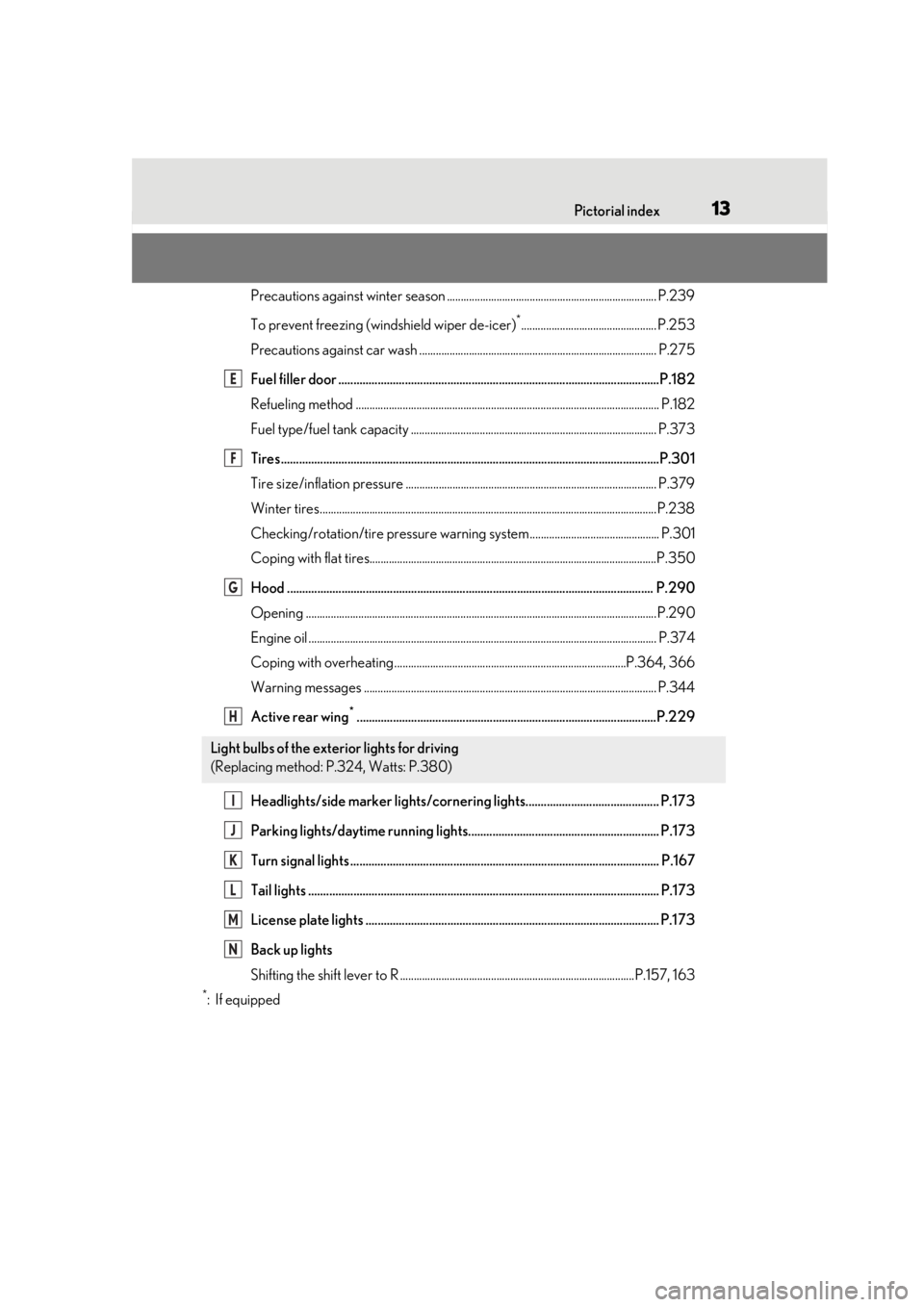
13Pictorial index
Precautions against winter season ............................................................................ P.239
To prevent freezing (windshield wiper de-icer)
*................................................. P.253
Precautions against car wash ...................................................................................... P.275
Fuel filler door ..........................................................................................................P.182
Refueling method .............................................................................................................. P .182
Fuel type/fuel tank capacity ...... ................................................................................... P.373
Tires.......................................................................................................................... ...P.301
Tire size/inflation pressure ........................................................................................... P.379
Winter tires..........................................................................................................................P.238
Checking/rotation/tire pressure warning system............................................... P.301
Coping with flat tires........................................................................................................P .350
Hood ......................................................................................................................... P. 290
Opening ........................................................................................................................ .......P.290
Engine oil ..................................................................................................................... ......... P.374
Coping with overheating ....................................................................................P.364, 366
Warning messages .......................................................................................................... P.344
Active rear wing
*...................................................................................................P.229
Headlights/side marker lights/cornering lights............................................ P.173
Parking lights/daytime running lights............................................................... P.173
Turn signal lights ...................................................................................................... P.167
Tail lights .................................................................................................................... P.173
License plate lights ................................................................................................. P.173
Back up lights
Shifting the shift lever to R .....................................................................................P.157, 163
*:If equipped
Light bulbs of the exterior lights for driving
(Replacing method: P.324, Watts: P.380)
E
F
G
H
I
J
K
L
M
N
Page 99 of 432
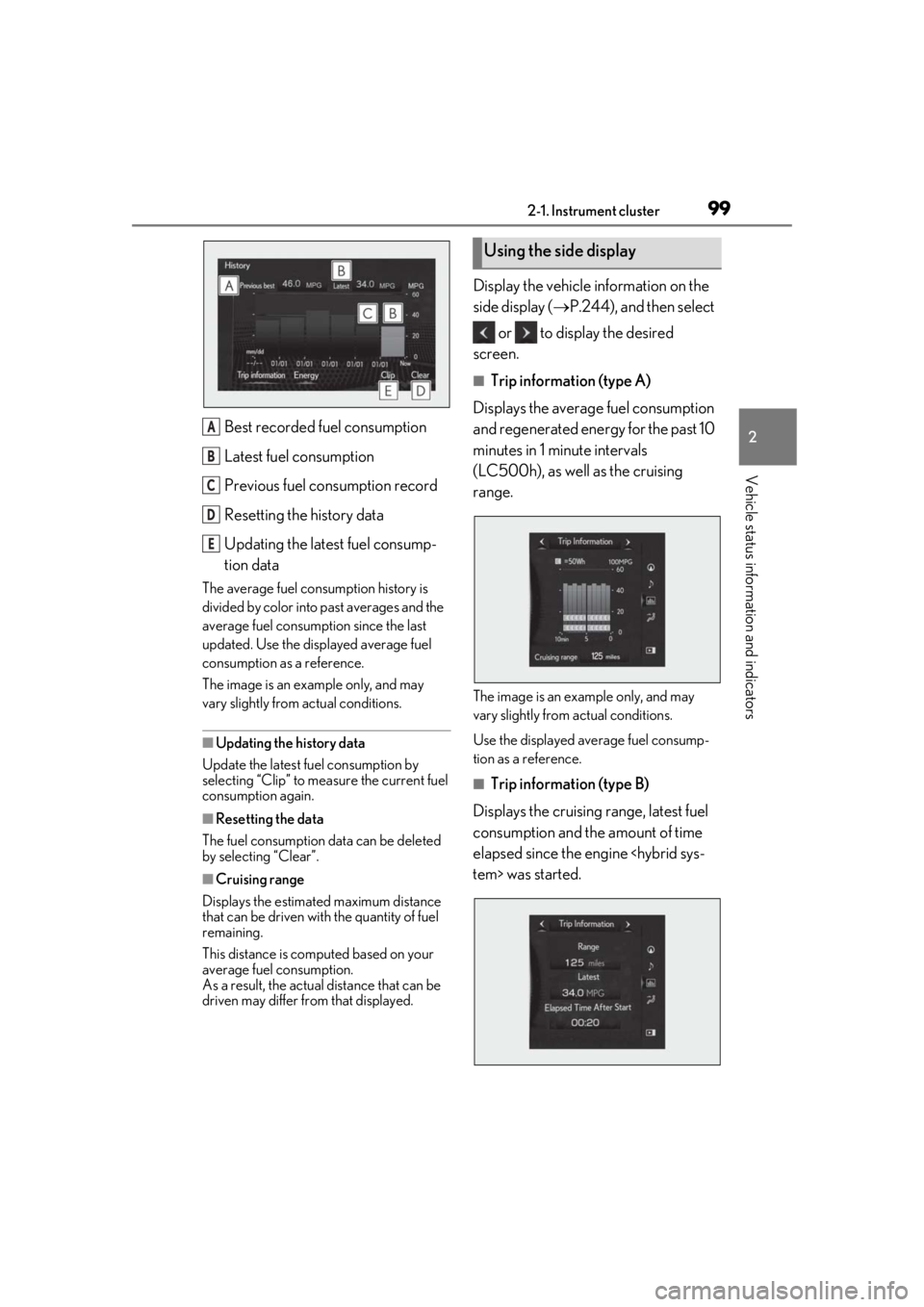
992-1. Instrument cluster
2
Vehicle status information and indicators
Best recorded fuel consumption
Latest fuel consumption
Previous fuel consumption record
Resetting the history data
Updating the latest fuel consump-
tion data
The average fuel consumption history is
divided by color into past averages and the
average fuel consumption since the last
updated. Use the displayed average fuel
consumption as a reference.
The image is an example only, and may
vary slightly from actual conditions.
■Updating the history data
Update the latest fuel consumption by
selecting “Clip” to measure the current fuel
consumption again.
■Resetting the data
The fuel consumption data can be deleted
by selecting “Clear”.
■Cruising range
Displays the estimated maximum distance
that can be driven with the quantity of fuel
remaining.
This distance is comp uted based on your
average fuel consumption.
As a result, the actual distance that can be
driven may differ from that displayed.
Display the vehicle information on the
side display ( P.244), and then select
or to display the desired
screen.
■Trip information (type A)
Displays the average fuel consumption
and regenerated energy for the past 10
minutes in 1 minute intervals
(LC500h), as well as the cruising
range.
The image is an example only, and may
vary slightly from actual conditions.
Use the displayed average fuel consump-
tion as a reference.
■Trip information (type B)
Displays the cruising range, latest fuel
consumption and the amount of time
elapsed since the engine
A
B
C
D
E
Using the side display
Page 137 of 432
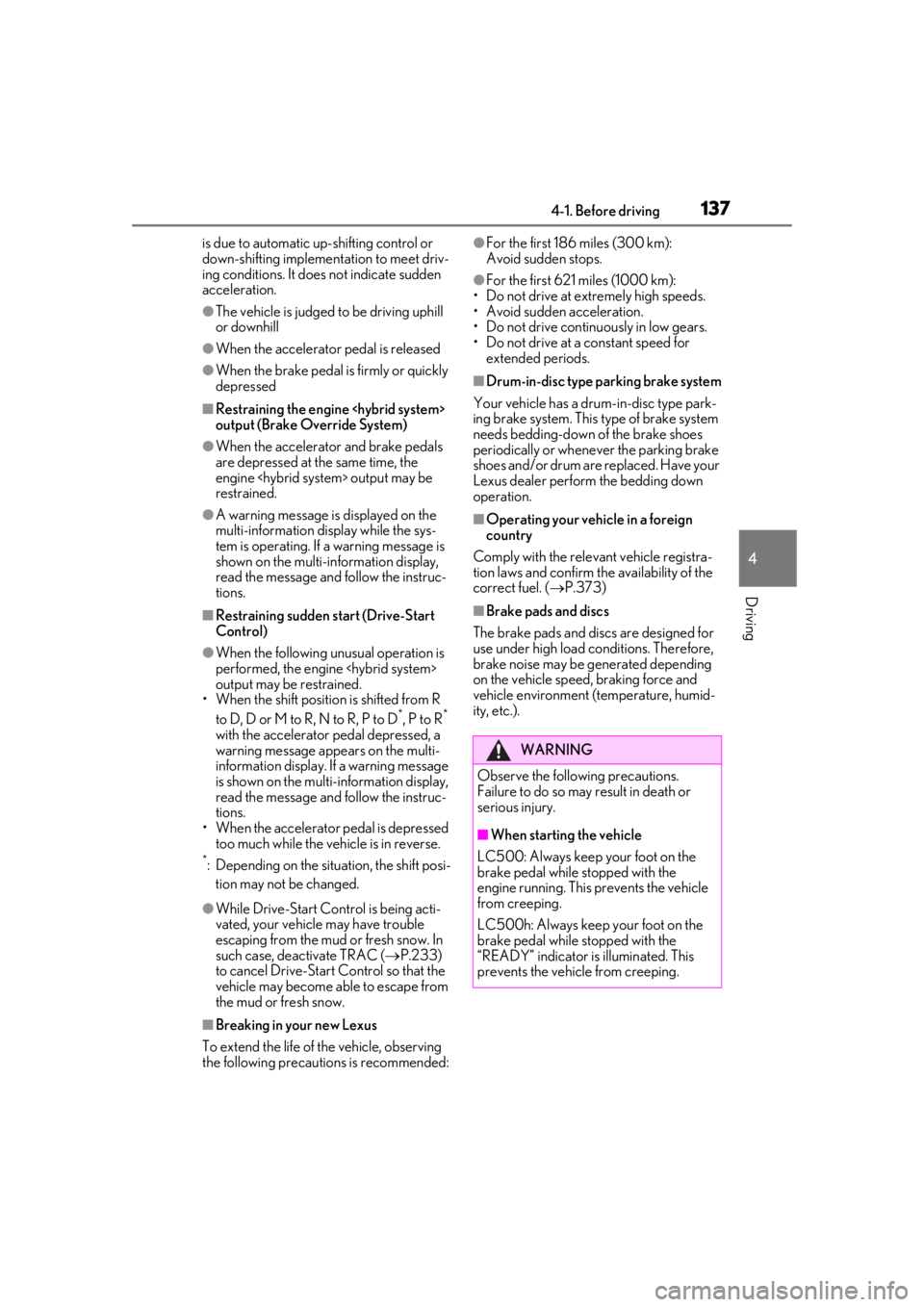
1374-1. Before driving
4
Driving
is due to automatic up-shifting control or
down-shifting implementation to meet driv-
ing conditions. It does not indicate sudden
acceleration.
●The vehicle is judged to be driving uphill
or downhill
●When the accelerator pedal is released
●When the brake pedal is firmly or quickly
depressed
■Restraining the engine
output (Brake Override System)
●When the accelerator and brake pedals
are depressed at the same time, the
engine
restrained.
●A warning message is displayed on the
multi-information display while the sys-
tem is operating. If a warning message is
shown on the multi-information display,
read the message and follow the instruc-
tions.
■Restraining sudden start (Drive-Start
Control)
●When the following unusual operation is
performed, the engine
output may be restrained.
• When the shift position is shifted from R
to D, D or M to R, N to R, P to D
*, P to R*
with the accelerator pedal depressed, a
warning message appears on the multi-
information display. If a warning message
is shown on the multi-information display,
read the message and follow the instruc-
tions.
• When the accelerator pedal is depressed
too much while the vehicle is in reverse.
*: Depending on the situation, the shift posi-
tion may not be changed.
●While Drive-Start Control is being acti-
vated, your vehicle may have trouble
escaping from the mud or fresh snow. In
such case, deactivate TRAC ( P.233)
to cancel Drive-Start Control so that the
vehicle may become able to escape from
the mud or fresh snow.
■Breaking in your new Lexus
To extend the life of the vehicle, observing
the following precautions is recommended:
●For the first 186 miles (300 km):
Avoid sudden stops.
●For the first 621 miles (1000 km):
• Do not drive at extremely high speeds.
• Avoid sudden acceleration.
• Do not drive continuously in low gears.
• Do not drive at a constant speed for extended periods.
■Drum-in-disc type parking brake system
Your vehicle has a drum-in-disc type park-
ing brake system. This type of brake system
needs bedding-down of the brake shoes
periodically or whenever the parking brake
shoes and/or drum are replaced. Have your
Lexus dealer perform the bedding down
operation.
■Operating your vehicle in a foreign
country
Comply with the relevant vehicle registra-
tion laws and confirm the availability of the
correct fuel. ( P.373)
■Brake pads and discs
The brake pads and discs are designed for
use under high load conditions. Therefore,
brake noise may be generated depending
on the vehicle speed, braking force and
vehicle environment (temperature, humid-
ity, etc.).
WARNING
Observe the following precautions.
Failure to do so may result in death or
serious injury.
■When starting the vehicle
LC500: Always keep your foot on the
brake pedal while stopped with the
engine running. This prevents the vehicle
from creeping.
LC500h: Always keep your foot on the
brake pedal while stopped with the
“READY” indicator is illuminated. This
prevents the vehicle from creeping.
Page 182 of 432
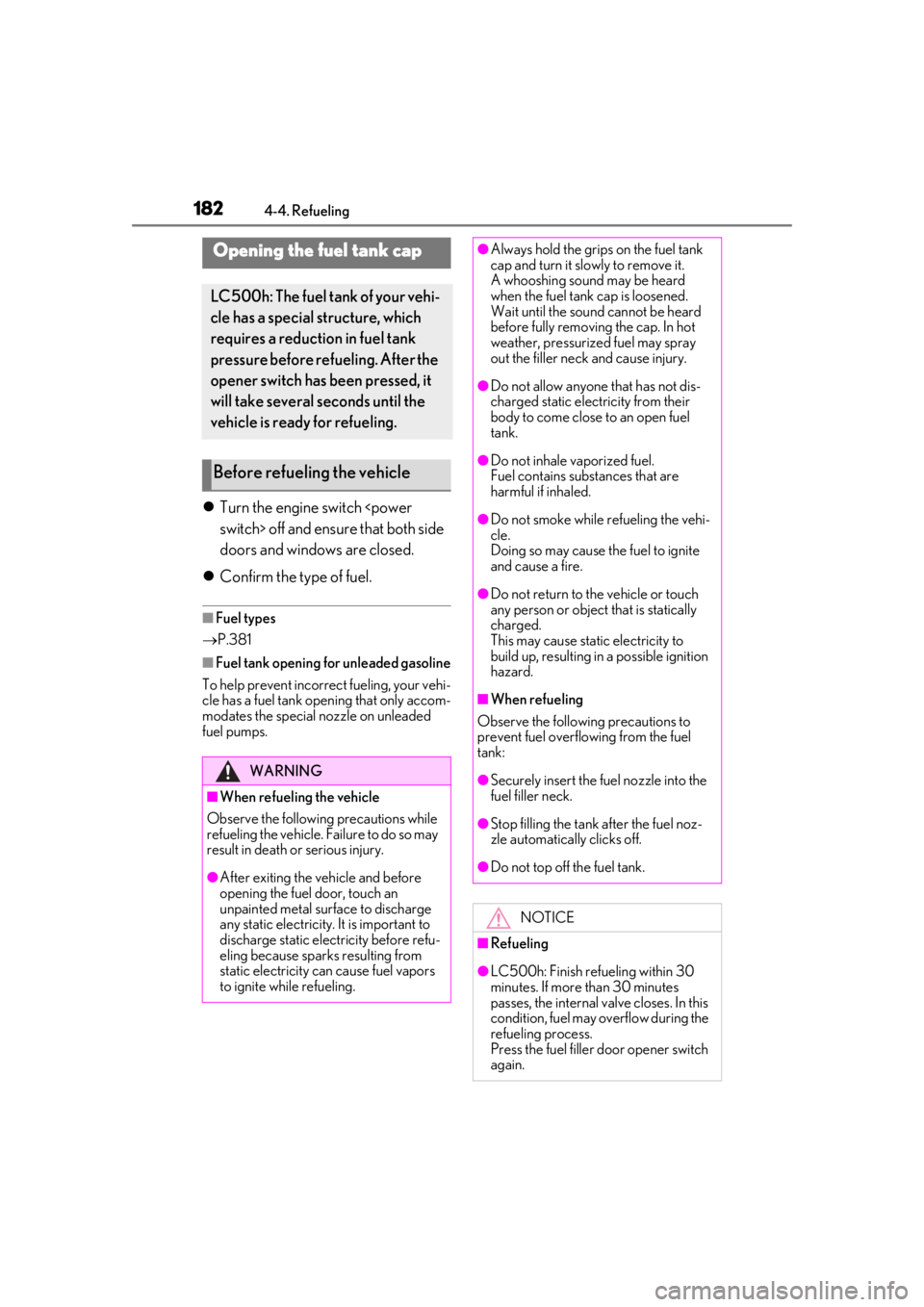
1824-4. Refueling
4-4.Refueling
Turn the engine switch
doors and windows are closed.
Confirm the type of fuel.
■Fuel types
P.381
■Fuel tank opening for unleaded gasoline
To help prevent incorrect fueling, your vehi-
cle has a fuel tank opening that only accom-
modates the special nozzle on unleaded
fuel pumps.
Opening the fuel tank cap
LC500h: The fuel ta nk of your vehi-
cle has a special structure, which
requires a reduction in fuel tank
pressure before refueling. After the
opener switch has been pressed, it
will take several seconds until the
vehicle is ready for refueling.
Before refueling the vehicle
WARNING
■When refueling the vehicle
Observe the following precautions while
refueling the vehicle. Failure to do so may
result in death or serious injury.
●After exiting the vehicle and before
opening the fuel door, touch an
unpainted metal surface to discharge
any static electricity. It is important to
discharge static electricity before refu-
eling because sparks resulting from
static electricity can cause fuel vapors
to ignite while refueling.
●Always hold the grips on the fuel tank
cap and turn it slowly to remove it.
A whooshing sound may be heard
when the fuel tank cap is loosened.
Wait until the sound cannot be heard
before fully removing the cap. In hot
weather, pressurized fuel may spray
out the filler neck and cause injury.
●Do not allow anyone that has not dis-
charged static electricity from their
body to come close to an open fuel
tank.
●Do not inhale vaporized fuel.
Fuel contains substances that are
harmful if inhaled.
●Do not smoke while refueling the vehi-
cle.
Doing so may cause the fuel to ignite
and cause a fire.
●Do not return to the vehicle or touch
any person or object that is statically
charged.
This may cause static electricity to
build up, resulting in a possible ignition
hazard.
■When refueling
Observe the following precautions to
prevent fuel overflowing from the fuel
tank:
●Securely insert the fuel nozzle into the
fuel filler neck.
●Stop filling the tank after the fuel noz-
zle automatically clicks off.
●Do not top off the fuel tank.
NOTICE
■Refueling
●LC500h: Finish refueling within 30
minutes. If more than 30 minutes
passes, the internal va lve closes. In this
condition, fuel may overflow during the
refueling process.
Press the fuel filler door opener switch
again.
Page 214 of 432
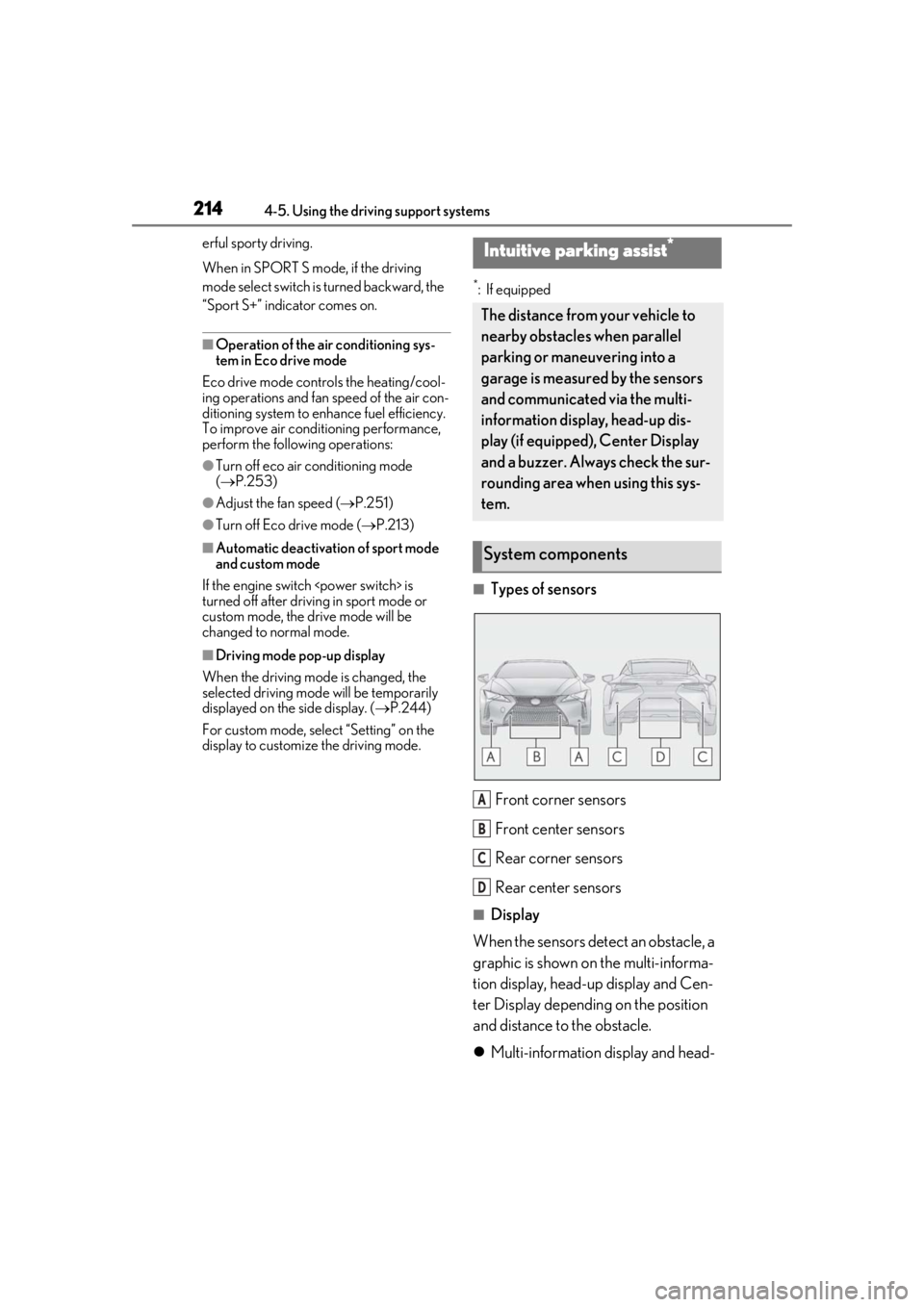
2144-5. Using the driving support systems
erful sporty driving.
When in SPORT S mode, if the driving
mode select switch is turned backward, the
“Sport S+” indicator comes on.
■Operation of the air conditioning sys-
tem in Eco drive mode
Eco drive mode controls the heating/cool-
ing operations and fan speed of the air con-
ditioning system to enhance fuel efficiency.
To improve air condit ioning performance,
perform the following operations:
●Turn off eco air conditioning mode
( P.253)
●Adjust the fan speed ( P.251)
●Turn off Eco drive mode ( P.213)
■Automatic deactivation of sport mode
and custom mode
If the engine switch
turned off after drivin g in sport mode or
custom mode, the drive mode will be
changed to normal mode.
■Driving mode pop-up display
When the driving mode is changed, the
selected driving mode will be temporarily
displayed on the side display. ( P.244)
For custom mode, select “Setting” on the
display to customize the driving mode.
*: If equipped
■Types of sensors
Front corner sensors
Front center sensors
Rear corner sensors
Rear center sensors
■Display
When the sensors detect an obstacle, a
graphic is shown on the multi-informa-
tion display, head-up display and Cen-
ter Display depending on the position
and distance to the obstacle.
Multi-information display and head-
Intuitive parking assist*
The distance from your vehicle to
nearby obstacles when parallel
parking or maneuvering into a
garage is measured by the sensors
and communicated via the multi-
information display, head-up dis-
play (if equipped), Center Display
and a buzzer. Always check the sur-
rounding area when using this sys-
tem.
System components
A
B
C
D
Page 274 of 432
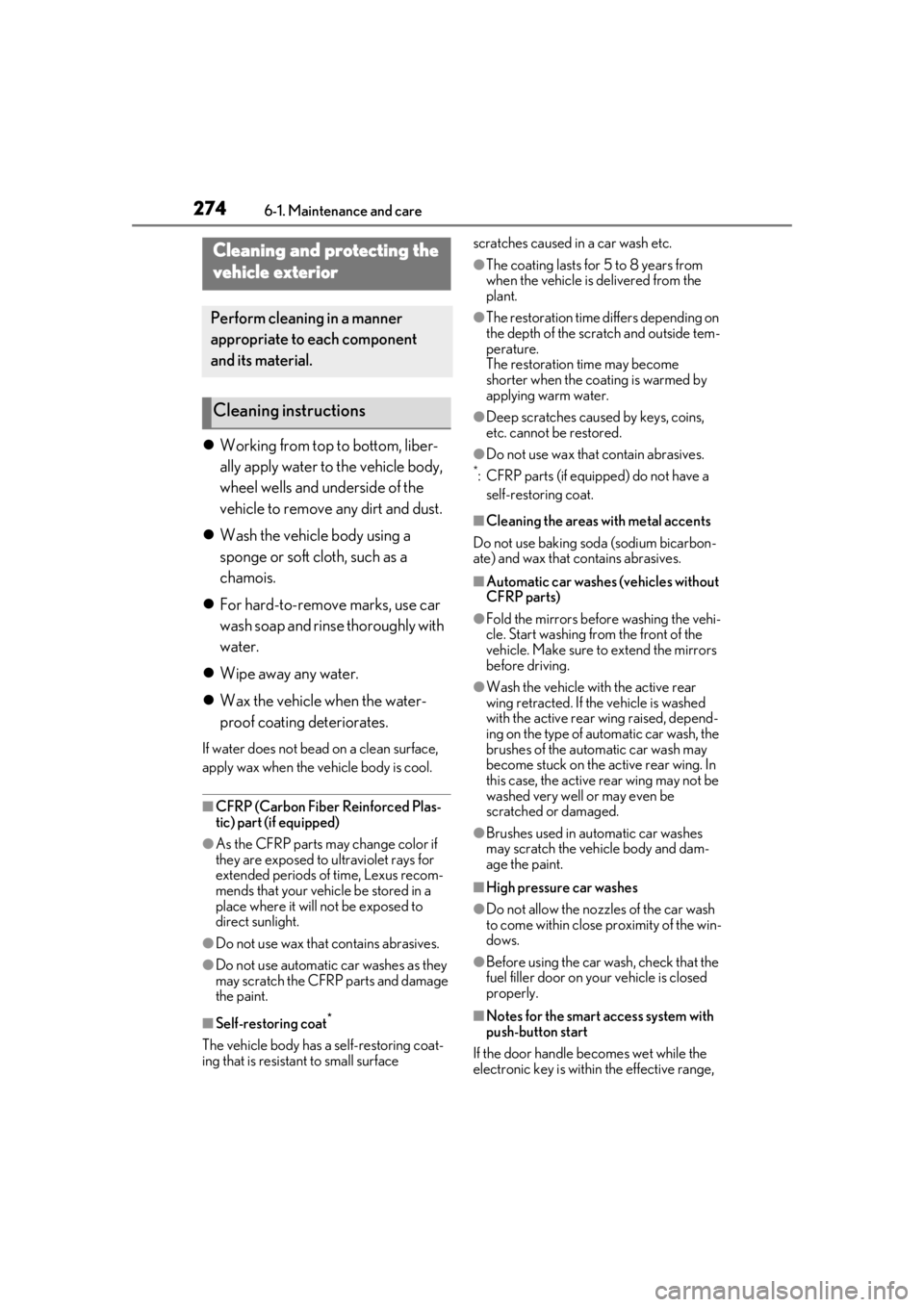
2746-1. Maintenance and care
6-1.Maintenance and care
Working from top to bottom, liber-
ally apply water to the vehicle body,
wheel wells and underside of the
vehicle to remove any dirt and dust.
Wash the vehicle body using a
sponge or soft cloth, such as a
chamois.
For hard-to-remove marks, use car
wash soap and rinse thoroughly with
water.
Wipe away any water.
Wax the vehicle when the water-
proof coating deteriorates.
If water does not bead on a clean surface,
apply wax when the vehicle body is cool.
■CFRP (Carbon Fiber Reinforced Plas-
tic) part (if equipped)
●As the CFRP parts ma y change color if
they are exposed to ultraviolet rays for
extended periods of time, Lexus recom-
mends that your vehicle be stored in a
place where it will not be exposed to
direct sunlight.
●Do not use wax that contains abrasives.
●Do not use automatic car washes as they
may scratch the CFRP parts and damage
the paint.
■Self-restoring coat*
The vehicle body has a self-restoring coat-
ing that is resistant to small surface scratches caused in
a car wash etc.
●The coating lasts for 5 to 8 years from
when the vehicle is delivered from the
plant.
●The restoration time differs depending on
the depth of the scratch and outside tem-
perature.
The restoration time may become
shorter when the coating is warmed by
applying warm water.
●Deep scratches caused by keys, coins,
etc. cannot be restored.
●Do not use wax that contain abrasives.*: CFRP parts (if equipp ed) do not have a
self-restoring coat.
■Cleaning the areas with metal accents
Do not use baking soda (sodium bicarbon-
ate) and wax that contains abrasives.
■Automatic car washes (vehicles without
CFRP parts)
●Fold the mirrors befo re washing the vehi-
cle. Start washing from the front of the
vehicle. Make sure to extend the mirrors
before driving.
●Wash the vehicle with the active rear
wing retracted. If the vehicle is washed
with the active rear wing raised, depend-
ing on the type of automatic car wash, the
brushes of the automatic car wash may
become stuck on the active rear wing. In
this case, the active rear wing may not be
washed very well or may even be
scratched or damaged.
●Brushes used in automatic car washes
may scratch the vehicle body and dam-
age the paint.
■High pressure car washes
●Do not allow the nozzles of the car wash
to come within close proximity of the win-
dows.
●Before using the car wash, check that the
fuel filler door on your vehicle is closed
properly.
■Notes for the smart access system with
push-button start
If the door handle becomes wet while the
electronic key is within the effective range,
Cleaning and protecting the
vehicle exterior
Perform cleaning in a manner
appropriate to each component
and its material.
Cleaning instructions
Page 352 of 432
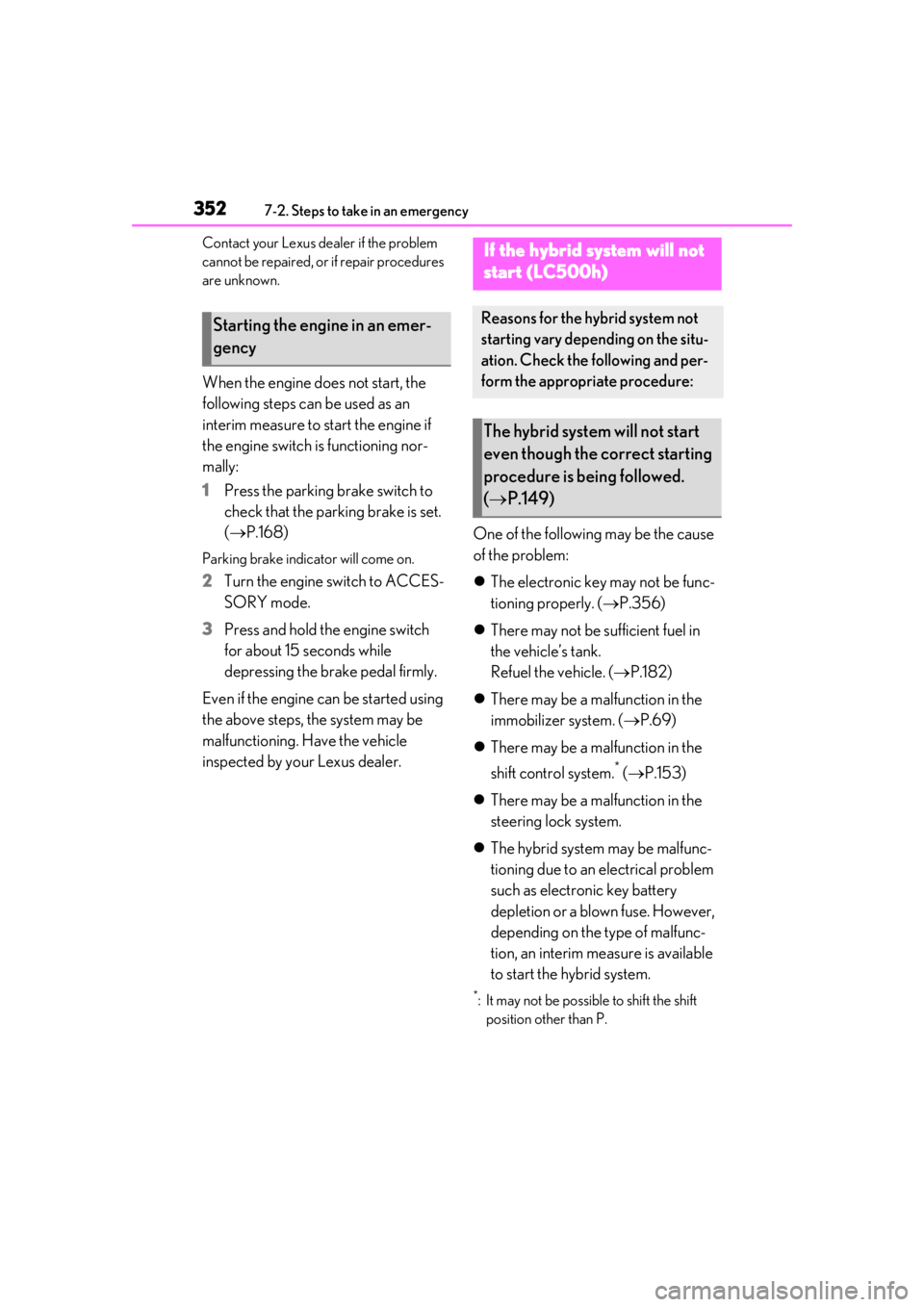
3527-2. Steps to take in an emergency
Contact your Lexus dealer if the problem
cannot be repaired, or if repair procedures
are unknown.
When the engine does not start, the
following steps can be used as an
interim measure to start the engine if
the engine switch is functioning nor-
mally:
1Press the parking brake switch to
check that the parking brake is set.
(P.168)
Parking brake indicator will come on.
2 Turn the engine switch to ACCES-
SORY mode.
3 Press and hold the engine switch
for about 15 seconds while
depressing the brake pedal firmly.
Even if the engine can be started using
the above steps, the system may be
malfunctioning. Have the vehicle
inspected by your Lexus dealer. One of the following may be the cause
of the problem:
The electronic key may not be func-
tioning properly. ( P.356)
There may not be sufficient fuel in
the vehicle’s tank.
Refuel the vehicle. ( P.182)
There may be a malfunction in the
immobilizer system. ( P.69)
There may be a malfunction in the
shift control system.
* ( P.153)
There may be a malfunction in the
steering lock system.
The hybrid system may be malfunc-
tioning due to an electrical problem
such as electronic key battery
depletion or a blown fuse. However,
depending on the type of malfunc-
tion, an interim measure is available
to start the hybrid system.
*: It may not be possible to shift the shift
position other than P.
Starting the engine in an emer-
gency
If the hybrid system will not
start (LC500h)
Reasons for the hybrid system not
starting vary depending on the situ-
ation. Check the following and per-
form the appropriate procedure:
The hybrid system will not start
even though the correct starting
procedure is being followed.
( P.149)
Page 373 of 432
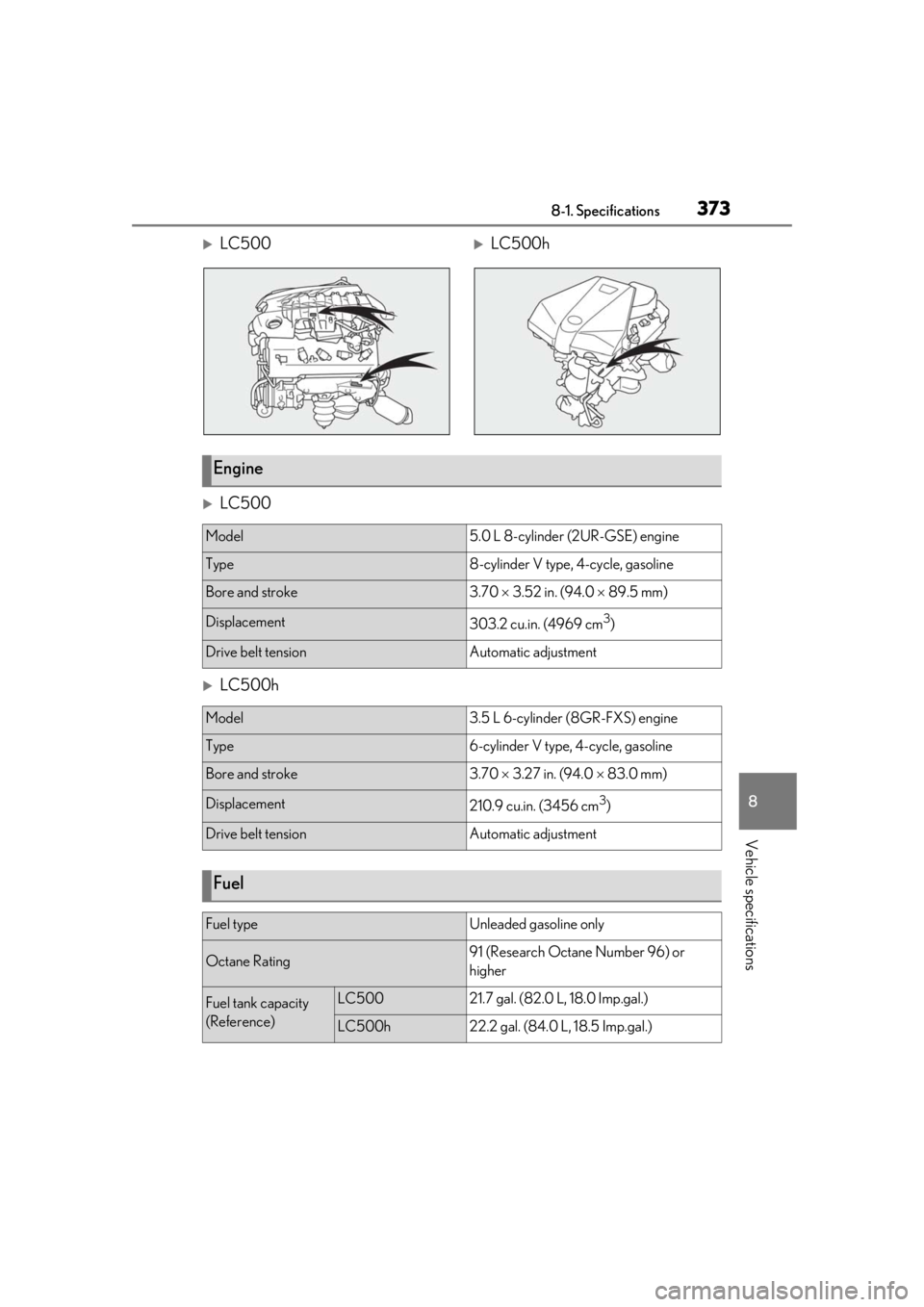
3738-1. Specifications
8
Vehicle specifications
LC500LC500h
LC500
LC500h
Engine
Model5.0 L 8-cylinder (2UR-GSE) engine
Type8-cylinder V type, 4-cycle, gasoline
Bore and stroke3.70 3.52 in. (94.0 89.5 mm)
Displacement303.2 cu.in. (4969 cm3)
Drive belt tensionAutomatic adjustment
Model3.5 L 6-cylinder (8GR-FXS) engine
Type6-cylinder V type, 4-cycle, gasoline
Bore and stroke3.70 3.27 in. (94.0 83.0 mm)
Displacement210.9 cu.in. (3456 cm3)
Drive belt tensionAutomatic adjustment
Fuel
Fuel typeUnleaded gasoline only
Octane Rating91 (Research Octane Number 96) or
higher
Fuel tank capacity
(Reference)LC50021.7 gal. (82.0 L, 18.0 Imp.gal.)
LC500h22.2 gal. (84.0 L, 18.5 Imp.gal.)